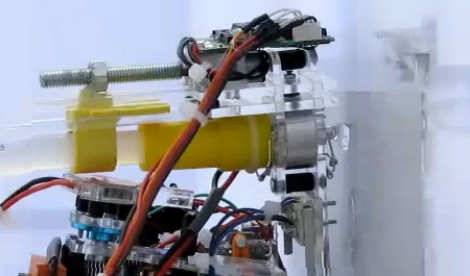
The problem of gripping all surfaces has always plagued the field of climbing robotics. But if you don’t care about damaging the wall, why not just let the robot glue its feet to the surface. That’s exactly how this robot does it, using a couple of climbing feet in conjunction with a hot melt glue gun wielding arm. It seems to be a predecessor of the hot glue 3D printing robot which we saw last week.
Check out the video to get a full overview of the climbing process, but here’s the gist of it. The legs and arm are able to pivot around the central axis of the robot, parallel to the climbing surface. Once one leg is glued in place the robot swivels around it so that the body is directly above that leg. From there it reaches up with the arm to deposit some glue on the wall, then moves it out of the way so the other foot can be pressed against the hot adhesive. When the newly attached foot has cooled sufficiently, the lower foot is reheated to free it from the wall. At this point the whole process repeats.
We’re still fond of vacuum-based climbers like this parachute-equipped robot. But the design of the hot-glue arm on this guy is something that might make it into one of our own projects someday.















Oh crap out of glue ahhhhhhhhhhhhh!
Seems kinda messy.
Seems to me the stuff never sticks :D
Someone needs to reseruct the Gecko Grip project 3M started awhile back but dropped it due to its lack of progress, but it uses micro fibers like gecko hairs to interact with a surface providing high grip. (I got 3M’s first demo product, so thats how I know about it!)
Interesting way to go about it. personally I find hot glue is sheet, does it really have a sheer strengthen of 15 kilograms per square centimeter as suggested in the linked article?
Blue tooth suggests operation without the tether. I think it would run out of battery before it runs out of glue.
Awesome video, a very happy robot. It’s probably very hard to implement, but I think the detaching could be implemented by some rolling action, or by adding some lever that would just push away from the wall.
15kg/cm2 is probably when the pulling force is applied evenly to the contact area. When being torn or peeled the force obviously doesn’t spread over the entire area.
seems a little useless way of doing it.